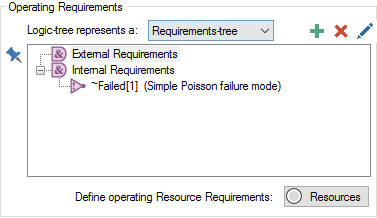 Note: The mathematics of
exponential/Poisson failure are described in detail in Appendix A.
Note: The mathematics of
exponential/Poisson failure are described in detail in Appendix A.
The default failure mode for both types of reliability elements is an exponential/Poisson failure mode that is never repaired.
The Failure Rate (also known as the hazard rate) represents the mean failure rate (the inverse of the mean time to failure), and has dimensions of inverse time. Failure is assumed to be a Poisson process (which implies that if the rate is constant, the time between events is exponentially distributed).
 Note: The mathematics of
exponential/Poisson failure are described in detail in Appendix A.
Note: The mathematics of
exponential/Poisson failure are described in detail in Appendix A.
Note that the Failure Rate does not have to be constant over time. You can enter this input as an expression (or a link from another element) that varies with time.
Failures modeled in this way are computed with respect to the time since the simulation started. If you wish to compute failures based on the operating time, or perhaps some other indirect metric (e.g., cumulative mileage), you must activate the advanced failure mode feature (by clearing the Use simple failure rate instead of failure modes checkbox). When you do so, a Failure Modes tab is added to the element, allowing advanced failure mode options to be accessed.
 Warning: The default
exponential failure mode is a very simple way to model failure (and therefore
should be used with caution). An unrepaired, exponential failure (with a
constant hazard rate) may be appropriate for random (and typically
externally-generated) failures, but is not likely to be appropriate for failure
due to processes such as wear and tear. As a result, GoldSim's advanced failure
mode features should be used for most components.
Warning: The default
exponential failure mode is a very simple way to model failure (and therefore
should be used with caution). An unrepaired, exponential failure (with a
constant hazard rate) may be appropriate for random (and typically
externally-generated) failures, but is not likely to be appropriate for failure
due to processes such as wear and tear. As a result, GoldSim's advanced failure
mode features should be used for most components.
By default, failures are assumed to be fatal to the component. That is, if a particular failure mode occurs, the component itself fails and is no longer operative. As a result, you will note that all failure modes are displayed as nodes (in the form of “Internal Requirements”) in the element’s Operating Requirements logic-tree:

Advanced failure mode options include the ability to add multiple failure modes (using a variety of failure distributions), the ability to create non-fatal failure and coupled failure modes, and the ability to simulate repair and preventive maintenance.
Learn more about: